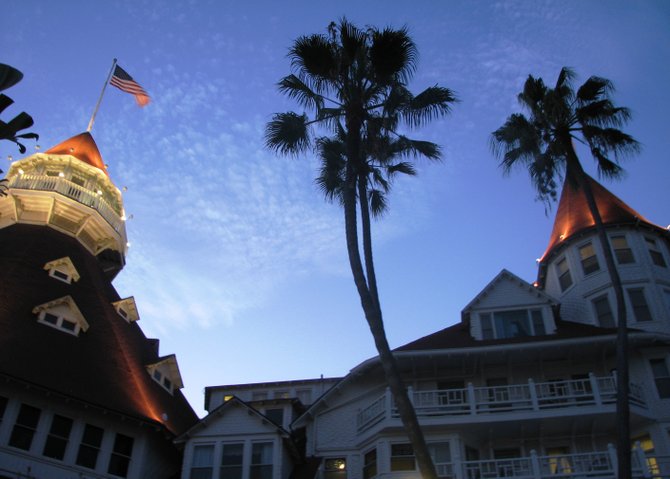 Facebook
Facebook
 X
X
 Instagram
Instagram
 TikTok
TikTok
 Youtube
Youtube

I float in a sun-warmed, peanut-shaped tile pool, watching the breeze flip the palm fronds against a turquoise San Diego sky, sipping a midday mimosa.
Cally, the woman for whom I was house sitting, had encouraged me to drink the champagne in their wine cellar, as they were no longer partial to the bubbly stuff. She and her husband had also told me to smoke their cigars since he suffers from angina, which the cigars seem to aggravate. Generous as their offer was, I had yet to even look in their humidor.
Rippling reflections of the afternoon sun on the water cast themselves against the six-foot-tall prickly pear, oak-planked door and the adobe-arched wall above it. Chimes sound; doves coo. Pretty nice for my first day in the trenches here in Coronado, California.
The city of Coronado evolved around the Hotel del Coronado, a National Historic Landmark, which was built primarily by Chinese immigrants in 1888 as a real estate draw by its developers during a land boom.
Although the scarcity of lumber in the arid desert environment first impeded development of this grand but wooden Victorian, Queen Anne Revival–style resort, the red-roofed wonder, once completed, was first in the world to offer electric lighting and oil furnace heating. Edison himself approved the final installation.
A saltwater pool, Japanese tea garden and ostrich farm lured princes and presidents – as well as a host of Hollywood starlets. The Hotel Del served as the backdrop for several novels and movies, including Some Like it Hot. And it was the setting for the movie version of Richard Matheson’s novel Bid Time Return called Somewhere in Time (although the novel’s setting was in fact at the Grand Hotel on Mackinac Island north of Chicago).
Coronado started as a seasonal Tent City, similar to that which founded Washington Grove outside Washington, D.C. Permanent vacation cottages eventually replaced the tents that had been erected south of the hotel.
Unlike Washington Grove, however, Coronado’s makeshift canvas city that flourished for almost forty years had nothing to do with summer revival meetings. The tents outfitted with electric lights served as the hotel’s economy rooms for seafaring families on a shoestring budget. A century later, tourism is still the bread and butter of this small suburban community, and the Hotel del Coronado – now with a four-star hospitality rating – is still a world-class draw.
As the synchronicity that seems ever-present in my current life would have it, Coronado’s North Island – once sold to the government, now a military training facility – served as the starting point for the transcontinental leg of Lindbergh’s New York-to-Paris 1927 solo flight across the Atlantic. I had recently visited Vikingsholm Castle on Lake Tahoe built by Lora Josephine Knight, the primary financial backer for his trend-setting flight.
Everything’s got a reason or a season, as the saying goes.


I float in a sun-warmed, peanut-shaped tile pool, watching the breeze flip the palm fronds against a turquoise San Diego sky, sipping a midday mimosa.
Cally, the woman for whom I was house sitting, had encouraged me to drink the champagne in their wine cellar, as they were no longer partial to the bubbly stuff. She and her husband had also told me to smoke their cigars since he suffers from angina, which the cigars seem to aggravate. Generous as their offer was, I had yet to even look in their humidor.
Rippling reflections of the afternoon sun on the water cast themselves against the six-foot-tall prickly pear, oak-planked door and the adobe-arched wall above it. Chimes sound; doves coo. Pretty nice for my first day in the trenches here in Coronado, California.
The city of Coronado evolved around the Hotel del Coronado, a National Historic Landmark, which was built primarily by Chinese immigrants in 1888 as a real estate draw by its developers during a land boom.
Although the scarcity of lumber in the arid desert environment first impeded development of this grand but wooden Victorian, Queen Anne Revival–style resort, the red-roofed wonder, once completed, was first in the world to offer electric lighting and oil furnace heating. Edison himself approved the final installation.
A saltwater pool, Japanese tea garden and ostrich farm lured princes and presidents – as well as a host of Hollywood starlets. The Hotel Del served as the backdrop for several novels and movies, including Some Like it Hot. And it was the setting for the movie version of Richard Matheson’s novel Bid Time Return called Somewhere in Time (although the novel’s setting was in fact at the Grand Hotel on Mackinac Island north of Chicago).
Coronado started as a seasonal Tent City, similar to that which founded Washington Grove outside Washington, D.C. Permanent vacation cottages eventually replaced the tents that had been erected south of the hotel.
Unlike Washington Grove, however, Coronado’s makeshift canvas city that flourished for almost forty years had nothing to do with summer revival meetings. The tents outfitted with electric lights served as the hotel’s economy rooms for seafaring families on a shoestring budget. A century later, tourism is still the bread and butter of this small suburban community, and the Hotel del Coronado – now with a four-star hospitality rating – is still a world-class draw.
As the synchronicity that seems ever-present in my current life would have it, Coronado’s North Island – once sold to the government, now a military training facility – served as the starting point for the transcontinental leg of Lindbergh’s New York-to-Paris 1927 solo flight across the Atlantic. I had recently visited Vikingsholm Castle on Lake Tahoe built by Lora Josephine Knight, the primary financial backer for his trend-setting flight.
Everything’s got a reason or a season, as the saying goes.
Comments